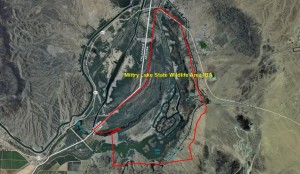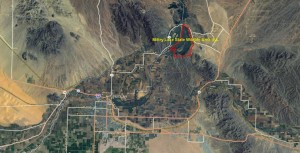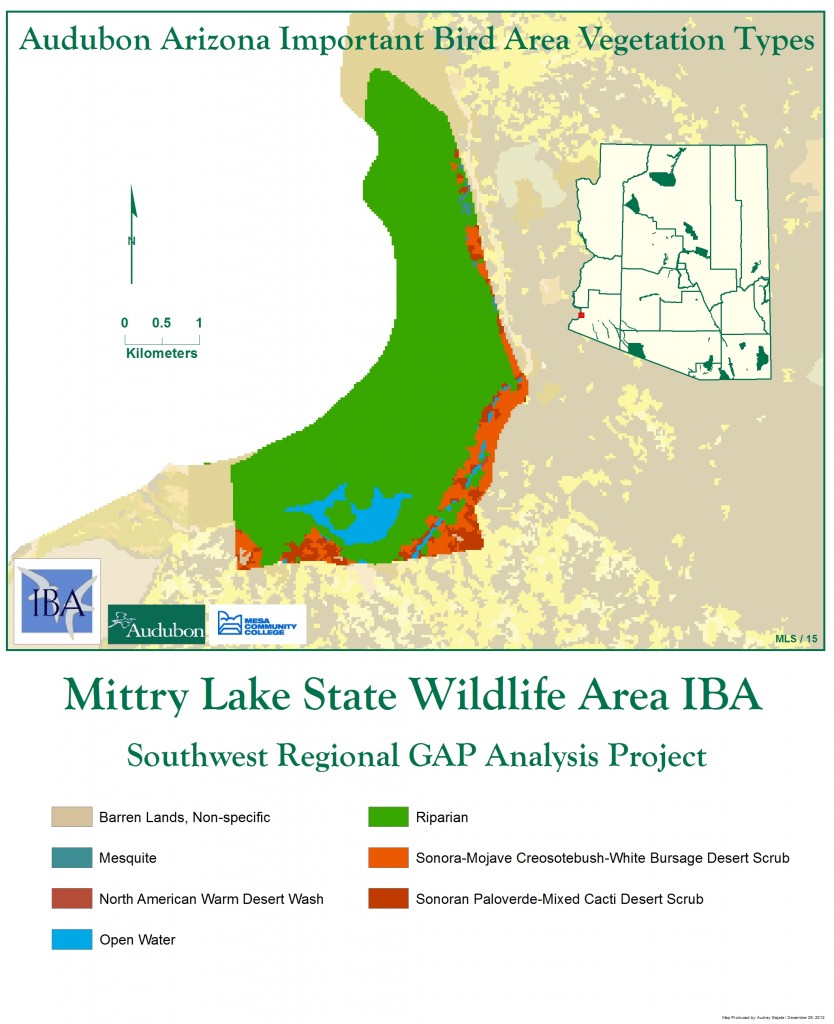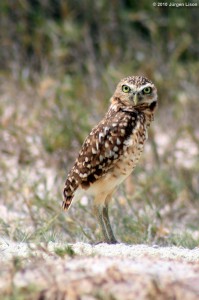Global IBA for Black Rail
Continental IBA for Yuma Clapper Rail
Site Steward: Yuma Audubon Society
Size: 6.2 square miles, 3,984 acres
Identified: 07/2002
Visiting the IBA: From Yuma, take Highway 95 north to East Imperial Dam Road, then turn left (west) toward the lake, following WA signs.
Ownership: BLM and Bureau of Reclamation, managed by Arizona Game and Fish
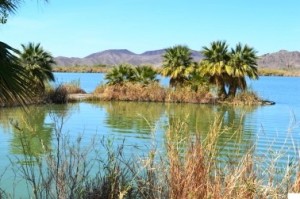 Site Description: Mittry Lake is a 400-acre oxbow of the Little Colorado River, with a well developed wetland and marsh habitat adjacent to harsh desert conditions. The Mittry Lake Wildlife Area includes about 600 acres of water surface and 2400 acres of marsh or upland. A wide variety of vegetative and wildlife species can be found here, with a scenic backdrop of three mountain ranges.
Site Description: Mittry Lake is a 400-acre oxbow of the Little Colorado River, with a well developed wetland and marsh habitat adjacent to harsh desert conditions. The Mittry Lake Wildlife Area includes about 600 acres of water surface and 2400 acres of marsh or upland. A wide variety of vegetative and wildlife species can be found here, with a scenic backdrop of three mountain ranges. 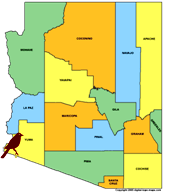 Numerous serpentine waterways connect to main lake body and make exploring by boat a unique experience. Mittry Lake Wildlife Area provides riparian, wetland, and aquatic habitat for many wildlife species. This is one of the most accessible settings for wildlife viewing in the Colorado River floodplain.
Numerous serpentine waterways connect to main lake body and make exploring by boat a unique experience. Mittry Lake Wildlife Area provides riparian, wetland, and aquatic habitat for many wildlife species. This is one of the most accessible settings for wildlife viewing in the Colorado River floodplain.
Birds: In winter, up to 10,000 waterfowl may be present This area contains some of the largest populations of Yuma Clapper Rails and California Black Rails in the southwest.
Year-round: Black-crowned Night-Heron, Green Heron, Great Blue Heron, Great Egret, Snowy Egret, Osprey, Western Grebe, Clark’s Grebe, Double-crested Cormorant, Loggerhead Shrike, Abert’s Towhee, and Red-winged Blackbird.
Breeding: Burrowing Owls, Virginia Rail, Sora, Least Bittern, American Bittern, Lesser Nighthawk, Bell’s Vireo, Common Yellowthroat, Yellow Warbler, and Blue Grosbeak.
Migration: Southwestern Willow Flycatchers, Vaux’s Swift, Tree Swallow, Violet-green Swallow, Bank Swallow, American Pipit, Nashville Warbler, MacGillivray’s Warbler, Townsend’s Warbler, Hermit Warbler, and Wilson’s Warbler
Winter: Northern Harrier, Sharp-shinned Hawk American Coots (large population), Sora, American White Pelican, Double-crested Cormorant, Wilson’s Snipe, and Belted Kingfisher.
eBird priority species: Bell’s Vireo, Abert’s Towhee, and Yellow Warbler.
Conservation Concerns: Tamarisk invasion is a major issue regarding the degradation of the riparian habitat. Increasing selenium levels also pose a significant threat to local bird populations. Leakage from the Gila Gravity Main Canal has created marsh habitat, that would be lost if this canal were lined. Fire burning widely in non-native vegetation is a threat.
Maps of this Important Bird Area:
State of the IBAs 2014 Baseline – More Technical info about the status of this Important Bird Area
National Audubon Profile Page for Mittry Lake State Wildlife Area IBA
Complete eBird.org Checklist of birds Reported for Mittry Lake State Wildlife Area IBA
For an interactive map and habitat and land ownership analysis of this IBA visit the National Audubon IBA Map and select “Arizona” and then the name of this Important Bird Area. To access analysis graphs, click on the map boundary of the IBA.
Location: 32.8205°N: 114.4689°W
County: Yuma
Site Status: Identified 07/2002
Ownership: BLM and Bureau of Reclamation
Area: 6.2 square miles, 3,984 acres
Criteria: A1: Global; Species of Global Conservation Concern – California Black Rail (30 breeding pairs – 2009)
B1: Continental: Species of Conservation Concern – Yuma Clapper Rail (62 breeding pairs – 2009)
D1: State: Species of Conservation Concern
D3: State: Species in rare/unique habitat: Marsh and Wetland
Site Description: A wildlife management area owned by the BLM and Bureau of Reclamation, and is jointly managed by these two agencies, and the Arizona Game and Fish Department (AZGFD). It consists of about 1100 acres of marsh and open water formed form Colorado River backwaters, old channels, and some dredging.
Desert-scrub and riparian woodland habitats are home to diverse desert wildlife. Neotropical birds find the area attractive. Riparian birds like the Yellow-billed Cuckoo, Summer Tanager, and the federally endangered Southwestern Willow flycatcher may use the area.
Yuma clapper rails nest on site. Surveys have also revealed California black rails, and Virginia rails nesting along the shore. The marsh also supports American coot, Common Moorhen, Western Least bittern, and Pied-billed grebe.
Winter users include duck species, Sora, American white pelican, Double-crested cormorant and Northern Harrier. Year-round users include Black-crowned Night-heron, Great Blue Heron, Snowy Egret, Osprey, and many others.
| Vegetation Description | Hectares |
| ARROWEED – SCRUB COMMUNITIES | 508.5813 |
| CREOSOTEBUSH – BURSAGE (LOWER COLORADO R. VALLEY) COMMUNITIES | 160030.4 |
| LAKE | 137.4921 |
| MIXED PALOVERDE – CACTI COMMUNITIES | 236.6091 |
| NOT LABELED ON MANUSCRIPT | 9.749686 |
| REED COMMUNITES | 480.4881 |
| TAMARIX DISCLIMAX COMMUNITIES | 243.3621 |
Ornithological Summary:
| Species or group | Season | Maximum | Year |
| Yuma Clapper Rail | Breeding | 164 individuals | 2000 |
| California Black Rail | Breeding | 60 individuals | 2000 |
| Least Bittern | Breeding | 60 individuals | 2002 |
| American Bittern | Breeding | Present | 2002 |
| Burrowing Owl | Breeding | Present | 2002 |
This area contains some of the largest populations of Yuma Clapper Rails and California Black Rails in the southwest. Good marsh habitat for other birds such as Virginia Rail, Sora, Least Bittern, and American Bittern. A large wintering population of American Coots (>5000 individuals) uses the area. Provides habitat for migrating Southwestern Willow Flycatchers and other neotropical birds. The area provides foraging and nesting habitat for herons and egrets, and supports a population of Burrowing Owls.
Conservation Issues: Tamarisk invasion is a major issue regarding the degradation of the riparian habitat. Increasing selenium levels also pose a significant threat to local bird populations. Leakage from the Gila Gravity Main Canal has created marsh habitat, that would be lost if this canal were lined. Fire burning widely in non-native vegetation is a threat.



